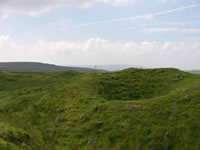 |
 |
 |
 |
 |
 |
 |
|
Fountains Abbey: History
Fountains Abbey: Buildings
|
A proactive community - the acquisition of lands through persuasion, purchase, exchange (8/33) The monks of Fountains were not simply passive recipients of grants. They actively sought to build up their holdings and to develop interests in specific areas to create compact estates. This generally meant expanding in places where the community had a grange or a series of granges, and by annexing holdings that were isolated, remote and more difficult to manage. One region where Fountains was keen to develop its holdings was Nidderdale, which lay to the south and south west of Fountains, and linked the abbey to the upland pastures of Craven. Fountains acquired lands in Nidderdale early on, mostly from the great Mowbray family, and developed a network of granges here. Bewerley grange functioned as the estate centre for the region and supported arable and pastoral farming, as well as iron and lead mining; it also provided a retreat and hospice for members of the community. Upper Nidderdale was developed as an important centre for dairy farming, for the lower slopes here were densely wooded and ideal for cattle. In the late fifteenth century (1496) there were 1700 sheep, and 380 stirks and bullocks at Nidderdale.(23) Flocks pastured at Craven for the summer were wintered at Nidderdale, where they arrived at Michaelmas and remained until St Helenmas Day (3 May). Fountains established a thriving fish industry in Lower Nidderdale, at Cayton. The community created a series of fish ponds in the gorge of the Dene, several of which can be seen today.(24)
The Nidderdale region also offered the potential to bring new land into cultivation, for example, at Fountains Earth, which stands to the north of Dacre. Pollen analysis has recently indicated that this was dense woodland, which was cleared by the monks in the late twelfth century to create arable and pasture.(25) |
